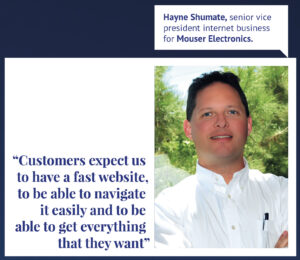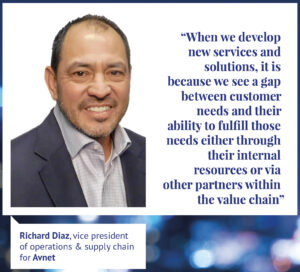
Buyers need distributors to provide more technical advice, market intelligence and cost-reducing value-added and supply chain services.
In the not-so- distant past the expectations that many electronics purchasers had of distributors were that distributors had the parts buyers needed in stock and would be able deliver them in a timely fashion.
But times have changed and buyers now expect much more from distributors. Some buyers regard their distributors as strategic partners and rely on them not just for parts and timely delivery, but also for cost-cutting value-added and supply chain services and for need-to-know market intelligence about the supply chain. They also want distributors to provide insight on environmental and social responsibility regulations and provide documentation that parts purchased meet those regulations. Buyers also want distributors that have design tools that make it easier for their companies’ engineers to find the best solution for new designs.
“Buyers’ expectations have changed immensely over the years,” said John Hufnagle, vice president, North American sales and engineered solutions for distributor PEI-Genesis. One reason is technology development. “The ability to access information, procure material, research technical information or evaluate buying patterns and vendor performance has advanced dramatically and continues to do so on a daily basis,” said Hufnagle.
He said buyers look to PEI-Genesis for insight when there are changes in market conditions, demand and lead times. “We see that now in certain product groups as the economy starts to rebound as a result of the COVID recovery,” said Hufnagle. “Our customers look to us for guidance and advice on navigating those waters.”
He said PEI-Genesis puts a strong focus on “value added selling whether it is the on-hand component inventory, a bond program for an 18-week lead time product, a cable assembly design and manufacture or a kit for engineering in the early stages of a design.”
Customers today are looking for a good user experience, said Hufnagle. “We take pride in helping our customers make the right choices,” he said. PEI-Genesis has as expansive portfolio of connectors and “we are able to evaluate applications, buying situations, available inventory, market conditions and guide customers to sensible decision making.”
Wayne Nelson, general manager at Benchmark Connector Corp., said more of Benchmark’s customers “expect us to have technical/performance answers to their questions about the products we provide,” he said. Buyers are also more concerned about environmental impacts of these products. “We spend a great deal of time filing out material/composition declarations then we ever had before,” said Nelson.
Responsiveness is more important to buyers especially over the past year during the pandemic. They expect a prompt response to an enquiry to a technical question or product usability, he said. “Most of my staff have their company emails on their personal phones which gives the customer almost around the clock availability,” said Nelson. Customers expect that a distributor will be “easy to work with, easy to communicate with and quick to respond,” said Nelson.
He added customers are looking for more in-depth information on origin of materials used in manufacturing and in the end products.
Nelson said buyers expect distributors to cut down on lead times by stocking millions of dollars’ worth of components “so we can custom assemble the connector they are looking for
quickly.” He added buyers are also always asking about when certain connectors may go obsolete. “Some companies ask every year about obsolescence of the same items. If an item becomes obsolete, they are looking for a suggestion for replacement,” said Nelson.
Lowest cost wanted
Richard Diaz, vice president of operations & supply chain for Avnet, said many buyers are looking for the lowest possible total cost when they buy parts. “How that cost is defined and measured, however, varies dramatically across the array of customers and industries that we serve,” said Diaz.
He said a small number of customers focus only on piece-part price. However, supply chain resiliency and risk mitigation “are certainly more likely to be factored into the total cost calculation for most customers,” especially during the pandemic, said Diaz.
 Avnet has a growing number of OEM and EMS customers whose business models and end customer demands require them to take a more comprehensive, total cost of ownership approach to their bill of material (BOM) sourcing. “This factors in everything from assurance of supply and business continuity to brand reputation concerns around ESG (environment social and guidance) and quality,” said Diaz. As a result, it is “critical for a distributor like Avnet to have an absolutely comprehensive understanding of the markets we serve and the customer profiles within these markets,” he said.
Avnet has a growing number of OEM and EMS customers whose business models and end customer demands require them to take a more comprehensive, total cost of ownership approach to their bill of material (BOM) sourcing. “This factors in everything from assurance of supply and business continuity to brand reputation concerns around ESG (environment social and guidance) and quality,” said Diaz. As a result, it is “critical for a distributor like Avnet to have an absolutely comprehensive understanding of the markets we serve and the customer profiles within these markets,” he said.
Buyers expect a range of services from Avent including traditional services such as inventory management, in plant stores, IC programming, kitting and cable assembly. The distributor has added new services based on customers’ need and are designed to reduce costs and guarantee continuity of supply.
“When we develop new services and solutions, it is because we see a gap between customer needs and their ability to fulfill those needs either through their internal resources or via other partners within the value chain,” Diaz said. He said on the design side there’s a growing need for more specialized design support in areas that many companies don’t have the bandwidth or resources to support. “For example, there aren’t as many engineers skilled in power management as there once were, so many OEM customers rely on Avnet’s power experts for guidance and support,” said Diaz.
IoT development, especially considering the complexity of integrating hardware and software connectivity into one solution, is a rapidly evolving field that requires a lot of time and attention to keep up with, he said.
Besides services, buyers rely on Avnet to aggregate not only demand, but market intelligence. He said there is a “real thirst for data and insights” from all customers across almost every segment, for market intelligence. “We may share this information informally through the normal course of our engagement with customers, or via an array of more structured reports and newsletters, like the Product & Technology News digital newsletter or the regular Product Lead Times & Supply Trends report our Americas’ team puts together,” said Diaz.
Be aware of services
In some cases, OEM and EMS customers are unaware of the services that a distributor can provide. For instance, Dave Doherty, president and chief operating officer of Digi-Key, said that customers may know that Digi-Key programs chips but may not know the extent of the distributor’s programming capabilities.
“We have a number of manufacturers that have given us access physically to equipment to do programming, such as on silicon timing devices, etc.” Manufacturer SiTime “refers everyone who wants some small quantity programmable timing devices to Digi-Key to have the devices programmed,” said Doherty. “We have a capable labor force here and the ability to program chips in small quantities very efficiently is right in our wheelhouse.”
Another service that may be under the radar is quick-turn, niche cable assemblies. “In some areas we do a number of different configurations of cabling and connectors, ribbon cables etc., but in a very confined area,” said Doherty. He said Digi-Key does not compete with customers that build cable assemblies. Those customers buy some of the components from Digi-Key “ and they produce value-added assemblies,” he said. “A number of them will sell their solutions on our website.”
Hayne Shumate, senior vice president Internet Business for Mouser Electronics, says customer expectations of distributors’ websites and purchasing and design tools have changed. Customers expect distributors to have a fast website, to be able to navigate it easily and to be able to get everything that they want, he said. “There is always pressure to make the tools better so people can show up and get what they need as quickly as possible,” he said.
Mouser takes feedback from its customers to develop new tools or to enhance existing ones. “We get an enormous amount of feedback every day. “There’s a constant stream of information coming from our customers about what they love about our website and what frustrates them,” he said. Mouser will factor customers’ feedback into decisions concerning its website tools.
In other cases, Mouser develops ideas for tools that customers didn’t know what is possible. For example, Mouser’s bill of materials tool has a feature that allows customers “to upload their spreadhseets and get their spreadsheets back with all the formatting they originally had with our data for price availability, import/export data, environmental information,” he said.
“No one asked us for that. But we thought folks that were sending us similarly formatted spreadsheets over and over again that might find it useful. And there’s a class of customer classifier that really appreciates that functionality,” he said.

